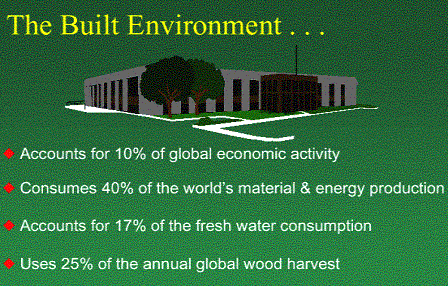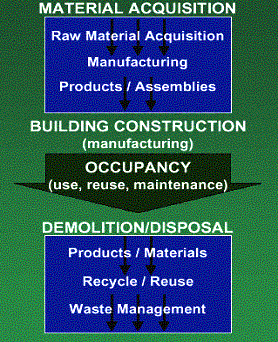Project Objectives
It
is the aims of this project to critically assess the LCA methodology in
terms of sustainable building design, and ascertain how effective this
methodology is in examining a complex product such as a building, listing
the benefits and restrictions of this assessment tool, and providing
recommendations for further development of this analytical tool where
appropriate.
It
was agreed that the best and most appropriate way of assessing the LCA
methodology when applied to a complex product such as a building, was to
draw conclusions from first hand experience by attempting to carry out an
LCA study of an existing building.
Previous
Building LCA Studies (What’s Missing?)
During
the literature review that was carried out at the start of this project,
several LCA studies on buildings were located, which incorporated studies
of the structural building materials and the energy requirements
throughout the building lifespan. However, it was clear from all previous
studies, that one thing which had been neglected was the life cycle of the
service systems employed within these buildings, which included the
wiring, plumbing, HVAC (if used) etc, and the overall impact that this had
in relation to the building life cycle.
Therefore, it was agreed that the group should also carry out an LCA of one of the service systems to use as a comparison in relation to the building as a whole entity, and to examine if the impact of the service system was high/medium/low. This would define if future LCA studies on building developments would require incorporation of the building service systems.
The service system that was chosen for examination was the wiring system, due to the fact that the wiring does not have many differing materials, which simplified the proposed LCA and made it possible to complete both the building and wiring LCA within the project timeframe.
Background
Sustainability
is probably the single most important issue to challenge the construction
industry in recent years. Sustainability covers a wide range of topics –
sustainable development, sustainable resource use, sustainable material
sources and so on.
In the UK half of all CO2 emissions result from energy used in
buildings, and every year construction consumes 6 tonnes of resources and
generates half a tonne of waste per citizen.
It is no surprise that demands for greater sustainability are coming from
a variety of sources: Government; construction industry customers;
building users; and local authorities. When referring to sustainable
building design, it is necessary to look at the global importance of
building development:

Life-cycle analysis (LCA) represents a rapidly emerging family of tools and techniques designed to help in environmental management and to foster sustainable development. LCA studies evaluate the “cradle-to-grave” costs and environmental impacts of products and processes. These studies give corporate decision-makers and designers, vital information and encourage innovative, sustainable technologies.
In this context, buildings can be seen as complex products, with associated life cycles that can be studied in a similar way to any product. The life cycle of a building can be partitioned into several phases:
Material Acquisition
This
phase incorporates the impacts associated with the construction material
manufacture, which incorporates each of the following:
· Raw material extraction
· Manufacturing of the building materials
· The energy required for manufacturing
·
Incorporated transport
Manufacturing
This
phase accounts for all process associated with the construction of the
building, including:
· Prefabrication of various components
· Energy used in the construction of the building
· The transport involved in delivering the raw materials to the construction site
Building
Use Phase
This
phase can also be viewed as the occupancy phase of the building and
envelopes all impacts associated with:
· The energy used within the building operation
· Maintenance of the building
· Replacement of building materials or prefabricated components
Elimination
Phase
All associated factors in the elimination of the building are encompassed:
· Deconstruction of the building
· Disposal or recycling of building materials
· Associated transport
The various life cycle stages of building development are shown in the figure below:

It is the aims of this project to critically assess the LCA methodology in terms of sustainable building design, and ascertain how effective this methodology is in examining a complex product such as a building, listing the benefits and restrictions of this assessment tool, and providing recommendations for further development of this analytical tool where appropriate.
Strategy
It was agreed that the best and most appropriate way of assessing the LCA methodology when applied to a complex product such as a building, was to draw conclusions from first hand experience by attempting to carry out an LCA study of an existing building.
For the purpose of this project, we have integrated the material acquisition and the manufacturing stages, and labelled this the pre-use phase, with the other two phases remaining the same. The reason for this was for simplification and clarity of results.
During the literature review that was carried out at the start of this project, several LCA studies on buildings were located, which incorporated studies of the structural building materials and the energy requirements throughout the building lifespan. However, it was clear from all previous studies, that one thing which had been neglected was the life cycle of the service systems employed within these buildings, which included the wiring, plumbing, HVAC (if used) etc, and the overall impact that this had in relation to the building life cycle. Therefore, it was agreed that the group should also carry out an LCA of one of the service systems to use as a comparison in relation to the building as a whole entity, and to examine if the impact of the service system was high/medium/low. This would define if future LCA studies on building developments would require incorporation of the building service systems.
The service system that was chosen for examination was the wiring system, due to the fact that the wiring does not have many differing materials, which simplified the proposed LCA and made it possible to complete both the building and wiring LCA within the project timeframe.